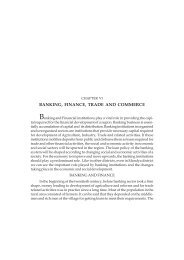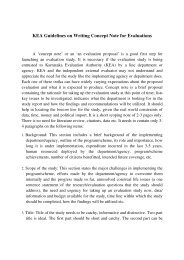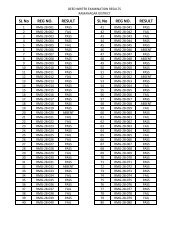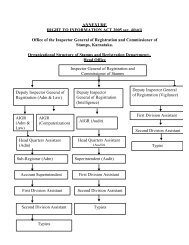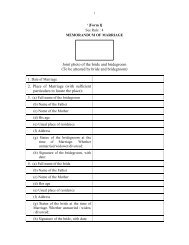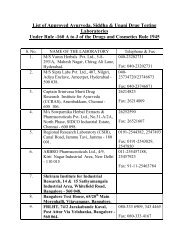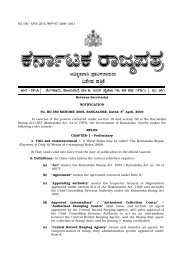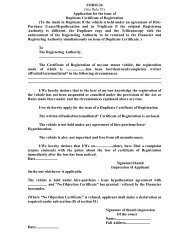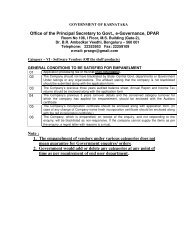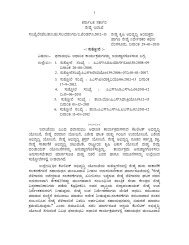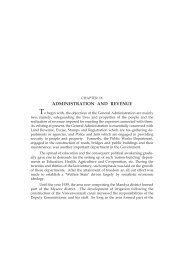Chapter XIII CULTURE - Government of Karnataka
Chapter XIII CULTURE - Government of Karnataka
Chapter XIII CULTURE - Government of Karnataka
Create successful ePaper yourself
Turn your PDF publications into a flip-book with our unique Google optimized e-Paper software.
A Handbook <strong>of</strong> <strong>Karnataka</strong> 518<br />
and solid. They also reveal familiarity with an astonishing number <strong>of</strong> these<br />
instruments which were in vogue. Among the stringed instruments kinnari,<br />
vellaki, vipanchi, ravanahasta, dandika, trisari, jantra, swaramandala and<br />
parivadini find a mention. Shankha, shringa, tittira, kahale, vamsa, bambuli<br />
are the wind instruments mentioned. Among the large number <strong>of</strong> percussion<br />
instruments ottu, karadi, mridanga, dhakka, patha, dundubhi, panava, bheri,<br />
dindima, traivali, nissala, dhamaru, chambaka, dande, dollu and ranja are<br />
prominently mentioned. Some solid instruments used were ghanta, jayaghanta,<br />
kinkini, jhallari, tala and kamsala. Palkuriki Somanatha mentions about 32<br />
types <strong>of</strong> veenas and 18 types <strong>of</strong> flutes.<br />
Khanda, Shukasarika, Tripadi, Chatushpadi, Shatpadi, Varna, Dhavala,<br />
Suladi, Pada, Vachana, Kirtana, Tattva, Ugabhoga were the different types<br />
<strong>of</strong> composition. <strong>Karnataka</strong> had a great number <strong>of</strong> reputed composers<br />
whose compositions are popular and relevant even today. There were many<br />
composers <strong>of</strong> the Veerasaiva faith like Sakalesha Madarasa, Basavanna,<br />
Nijaguna Shivayogi, Muppina Shadakshari, Bala Leela Mahanta Shivayogi,<br />
Nagabhushana Ghanamatarya, Madivalappa Kadakola, Nanjunda Shivayogi,<br />
Karibasavaswamy and Sarpabhusana Shivayogi. The Haridasa Kuta is said<br />
to have been founded by Narahari Teertha, the disciple <strong>of</strong> Madwacharya.<br />
Sripadaraya was called Haridasa Pitamaha. The Haridasas composed songs<br />
in Kannada in praise <strong>of</strong> Lord Vishnu. Vyasaraya, Vadiraja, Purandaradasa,<br />
Kanakadasa and others composed Kirtanas. Mummadi Krishnaraja Wodeyar<br />
was also an able composer.<br />
Purandaradasa strode like a colossus in the musical history <strong>of</strong> <strong>Karnataka</strong>.<br />
‘Pillari geetas’ composed by Purandarasa form the foundation for learning<br />
<strong>Karnataka</strong> music even today. Purandaradasa is revered as the ‘<strong>Karnataka</strong><br />
Sangita Pitamaha’ and is credited to have given a new direction to Karnatak<br />
music.<br />
In the 19th and 20th centuries, there was a marked separation <strong>of</strong> the popular<br />
and classical compositions. Mysore Sadashiva Rao adorned the royal court <strong>of</strong><br />
Mysore and was the guru <strong>of</strong> celebrities like Veena Subbanna, Sheshanna and<br />
others. Mysore Sadashiva Rao, Subbanna, Sheshanna. Sambaiah, Muthaih<br />
Bahgvathar, Mysore K. Vasudevacharya (composed in Kannada, Sanskrit<br />
and Telugu), Devottama Jois, Karigiri Rao, Bidaram Krishnappa, Mysore T.<br />
Chowdaiah, Jayachamaraja Wodeyar, Aliya Lingaraja, Veena Krishnacharya,<br />
Rudrapattnam Venkataramanayya, Tiruppanandal Pattabhiramaiah, Kolar<br />
Chandrashekara Sastry, Bellary Raja Rao and others have left behind a rich<br />
tradition <strong>of</strong> their compositons. Among the lady musicians mention may be<br />
made <strong>of</strong> Bangalore Nagarathamma who renovated the samadhi <strong>of</strong> Sri Tyagaraja<br />
at Thiruvaiyar.<br />
The reign <strong>of</strong> the Wodeyar <strong>of</strong> Mysore may be considered the golden age <strong>of</strong> music<br />
in <strong>Karnataka</strong>. They extended patronage to local musicians and also musicians<br />
<strong>of</strong> other regions. Veena Bhakshi Venkatasubbayya, Shivaramaiah, Pallavi<br />
Ramalingaiah and Lakshminarayana were prominent among the musicians<br />
<strong>of</strong> the state who received royal patronage. Other eminent vocalists who lived<br />
elsewhere or graced the Mysore durbar were Sadashiva Rao, Lalgudi Ramayyar,



